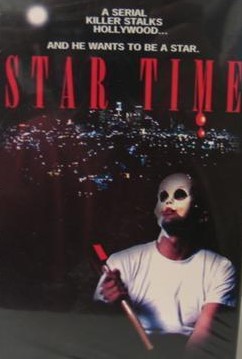 One of the most idiosyncratic of the many nineties-era serial killer dramas was this surreal account of a TV junkie becoming a mass murderer. Visually striking and eccentric, it gets a muted recommendation despite some very real narrative shortcomings.
One of the most idiosyncratic of the many nineties-era serial killer dramas was this surreal account of a TV junkie becoming a mass murderer. Visually striking and eccentric, it gets a muted recommendation despite some very real narrative shortcomings.
Both STAR TIME and its talented writer-director have been forgotten (the film was shadowed by similarly themed early-nineties offerings like MAN BITES DOG and NATURAL BORN KILLERS), but it made a minor splash on the cult movie circuit back in 1993, playing midnight showings at select theaters across the US and scoring a VHS release on Monarch Home Video (no DVD/Blu-ray release, to my knowledge, is forthcoming). It was the feature debut of Alexander Cassini, who went on to direct the Full Moon children’s film THE INCREDIBLE GENIE in 1999…and not much else.
Henry is a severely disturbed TV junkie. Upset that his favorite show is being taken off the air, Henry is about to commit suicide when he’s visited by a creepy middle-aged guy named Sam Bones. Sam, it seems, is a showbiz talent scout who wants to make Henry his latest client. Sam takes him into a surreal realm of living TV monitors where he gives Henry a baby mask and a mallet, and encourages him to embark on a killing rampage.
Sam drops Henry off at the house of a suburban family, and orders him to go inside and make some “art.” Henry can’t go through with such artistry at first, but after some encouragement from Sam he reenters the house and carries out his gruesome business. Over a dozen more killings follow, with Henry becoming known in the media as the Baby Mask killer.
The latest Sam-designated victim is Henry’s would-be girlfriend Wendy. Henry becomes determined to protect Wendy, and in the process learns some disturbing truths about Sam and himself.
Filmmaking-wise control is what STAR TIME has in its favor—in fact it may be a bit too controlled, with Alexander Cassini’s pared-down mise-en-scene, marked by ultra-precise lighting and a complete absence of subplots or supporting characters, often feeling downright claustrophobic.
There’s some striking imagery on display, particularly in a room filled with TV monitors, each showing a close-up of a different portion of a woman’s anatomy—an image that would appear to have been inspired by THE BLIND BEAST/MOJU. Other, more obvious influences include the films of Stephen Sayadian, a.k.a. Rinse Dream (particularly CAFÉ FLESH and DR. CALIGARI), which closely resemble STAR TIME in look and atmosphere (and its notably heavy sexual content), and also VIDEODROME. For that matter, its overall arc foreshadows FIGHT CLUB, with a final twist that isn’t exactly difficult to foresee.
The insidious-power-of-the-media message was already old hat by the time this film made its debut. Cassini’s juxtaposition of violent (though never very much so) imagery with TV gameshow glitz makes the film’s points better than any of the dialogue, which leans toward the clichéd and obvious. The entire script, in fact, is a problem, proving time and again that Cassini’s writing abilities are not in sync with his visual skills. This is evident in the one-note narrative, which has a riveting set-up but never really goes anywhere very compelling.
The film at least has a terrifically imposing performance by the late John P. Ryan, who really had a way with bad guy roles. Unfortunately, the teen heartthrob Michael St. Gerard (who played Elvis Presley in two features and one TV series), while fairly good in the lead role, is a bit too hunky to be fully believable as a psychotic misfit.
Vital Statistics
STAR TIME
Monarch Home Video/Northern Arts Entertainment, Inc.
Director/Producer/Screenwriter: Alexander Cassini
Cinematography: Fernando Arguelles
Editing: Stan Salfas
Cast: Michael St. Gerard, John P. Ryan, Maureen Teefy, Thomas Newman
